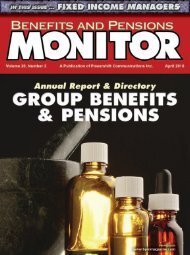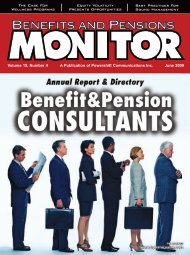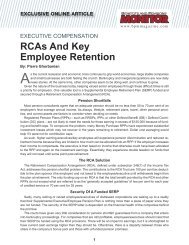BPM October 2010.indd - Benefits and Pensions Monitor
BPM October 2010.indd - Benefits and Pensions Monitor
BPM October 2010.indd - Benefits and Pensions Monitor
Create successful ePaper yourself
Turn your PDF publications into a flip-book with our unique Google optimized e-Paper software.
Governing Capital Accumulation Plans In 2010 3<br />
you put yourself in the members’ shoes, it can be overwhelming,<br />
or, they may think they are rich with a seemingly large balance of,<br />
say, $100,000.<br />
SINNAEVE: Yes, funding adequacy <strong>and</strong> underst<strong>and</strong>ing what<br />
adequacy means are important, however, I think this all leads back<br />
to a key point that Deborah raised when she spoke to defi ning<br />
the purpose of the plan. Is it to provide a signifi cant contribution<br />
towards retirement savings or to promise a fully funded retirement<br />
benefi t? Plan sponsors are making a signifi cant contribution <strong>and</strong><br />
certainly wish to provide the information <strong>and</strong> tools to assist plan<br />
members but does their promise extend to assuring adequacy for<br />
lifestyle needs whether in a DB or DC plan?<br />
MODERATOR: Are providers switching the focus<br />
from providing education to members, to helping<br />
sponsors engage their members to use these tools?<br />
JOHANNSON: Engagement is part of the challenge Marc mentioned.<br />
For example, if you have an employee base with a lot of<br />
20-somethings, it’s going to be hard to engage them in retirement<br />
savings discussions. It just isn’t relevant in terms of what they’re<br />
thinking today.<br />
To me, we have to fi nd realistic ways to engage employees early<br />
in life when compounded savings can deliver such a tremendous<br />
benefi t. We need to speak to what interests them now <strong>and</strong> leverage<br />
that into trying to save for the future.<br />
How can you engage that younger employee? To me, it’s a matter<br />
of speaking to both sides of the balance sheet. Younger people<br />
are trying to fi nance today’s needs, let alone fi nance their future<br />
in retirement. They need to look at how to manage their money<br />
to accomplish both. Engaging them with how to meet their needs<br />
of today more effi ciently can help them free up contributions to<br />
achieve an employer match <strong>and</strong> save meaningfully for the future.<br />
But to get there, you have to speak to their current needs, not just<br />
those when they are in retirement. This can be part of member communications,<br />
seminars, <strong>and</strong> tools to better engage the younger employee.<br />
MODERATOR: Where do the CAP guidelines fi t in<br />
today?<br />
NEWTON: In my view, the guidelines are totally inadequate<br />
®<br />
when you compare the level of regulation <strong>and</strong> guidelines that we<br />
have here versus the U.S., totally inadequate. They don’t capture a<br />
wide range of issues around fi duciary obligations <strong>and</strong> other obligations<br />
that employers have. They really don’t cover off the leading<br />
edge of what a CAP plan could <strong>and</strong> should provide.<br />
Numerous times during the discussions developing these guidelines,<br />
the CAP committee chair expressed the view that they were<br />
intended more for the mom <strong>and</strong> pop shop with a dozen employees<br />
as it is assumed that the expertise is already out there for the bigger<br />
employers like Hudson’s Bay.<br />
I disagree. The guidelines should be here to present a model that<br />
employers try to reach. These are really minimum practice guidelines<br />
<strong>and</strong> that’s not where we want to be in the Canadian marketplace.<br />
BEESLEY: As a small sponsor, we have less than 150 members<br />
<strong>and</strong> just trying to administer a plan keeps me running. We have to<br />
rely heavily on our service providers.<br />
Maybe if there was a balance between governance <strong>and</strong> some of<br />
the safe harbours that the U.S. has, that would be better.<br />
When you are presented with a certain amount of risk, you have<br />
to mitigate it somehow. For us, it is necessary to look for ways to<br />
outsource or otherwise fi nd a balance between member needs <strong>and</strong><br />
the needs of the employer or sponsor.<br />
We fi nd it really diffi cult.<br />
LODER: It’s a really big struggle for plan fi duciaries these days<br />
to govern programs appropriately or to even think about what is<br />
appropriate because the guidelines, in some aspects, are very much<br />
open to interpretation as to what adequate compliance means.<br />
However, governance budgets for DC plan sponsors are diminishing,<br />
especially if committee members have multiple roles within<br />
an organization. You’re basically balancing two things. You’re balancing<br />
risk management, which often becomes the primary focus,<br />
with the often competing objective of maximizing the outcome for<br />
the employee.<br />
MODERATOR: How about from a provider perspective?<br />
Do you feel that the CAP guidelines are<br />
adequate? Would you be amenable to tightening<br />
them up?<br />
SINNAEVE: Objectively, there’s certainly a fundamental need<br />
for recognizing what the goal of the program is <strong>and</strong> actually putting<br />
it in the full context.<br />
There are many variables <strong>and</strong> it’s very much a continuum. And<br />
that means different things for different people in their own situations<br />
in their lives.<br />
What we need overall are appropriate st<strong>and</strong>ards, not necessarily<br />
just for the CAP guidelines, but in terms of the fundamental access<br />
that individuals have to all sources of potential retirement income<br />
across all aspects of the Canadian retirement system. As this can<br />
evolve over the timeline of an individual’s working life – or the life<br />
of a DC plan – we have to be more dynamic <strong>and</strong> open-minded in<br />
our thinking.<br />
From the plan member’s perspective, they are the centre of the<br />
universe <strong>and</strong> they really have to have a sense of awareness of all<br />
aspects of the retirement system available to them – the government<br />
programs, plan contributions <strong>and</strong> its variables, <strong>and</strong> their own<br />
savings capacity. If, as a plan sponsor or an industry service provider,<br />
we’re working towards helping people underst<strong>and</strong> what they<br />
need to do in terms of overall planning, that’s a starting point.<br />
SPONSORED SECTION









